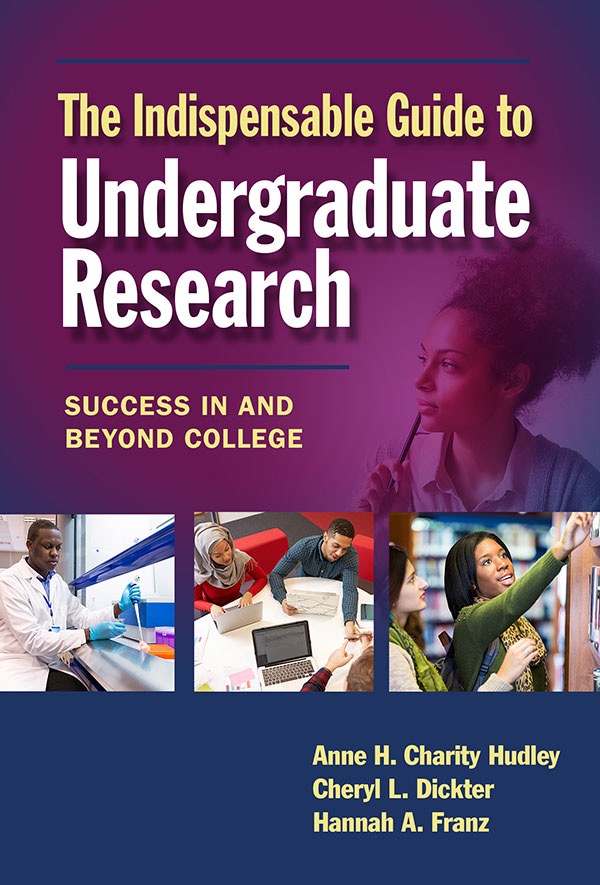undergraduate research
Select an item by clicking its checkbox

The Indispensable Guide to Undergraduate Research - Success in and Beyond College
Date Reviewed: April 16, 2018
This brief handbook and reference work was designed for college and university students interested in doing research. Charity Hudley, Dickter, and Franz present scholarly research as an exciting way for undergraduates to make the transition from students who learn to scholars who join an ongoing conversation as “masters of knowledge and challengers of the status quo” (5). The authors purposely construct the guide to serve not only as a resource but also as a model of a research-based approach to scholarly writing; they frequently comment on their own working methods and the research process that went into the composition of this text. The resulting book effectively demystifies the world of academia and the work of scholars, making research approachable and appealing.
Throughout the guide, the authors encourage students to pursue their academic and personal interests by becoming researchers, and they provide an impressively comprehensive roadmap for the research process. The book takes a special interest in guiding first-generation college students and students from historically underrepresented populations. The tone is collegial, and the text abounds with concrete advice about navigating the concomitants of scholarly research, from how to email a potential research mentor (80) to how to identify and access campus resources that can assist with time and energy management (49). Chapter 2, devoted to getting started, describes what research looks like across several academic disciplines and details ways different schools support and reward undergraduate research. Personal accounts from student scholars provide additional relatable voices and create the sense of a broad academic community into which readers are invited. The authors also emphasize the importance of sharing research results with a variety of audiences; Chapter 5, “Writing and Presenting Research” (91-116), describes different venues for written and oral communication that increase the impact of a student’s project, including conferences, articles, books, and social media.
A particularly valuable contribution of this book is its focus on empowering students from underrepresented populations. In addition to devoting a chapter to describing challenges that students from minority populations face and some tools for overcoming those challenges (“Underrepresented Scholars in the Academy: Making a Way,” [117-142]), the authors consistently highlight the value of diverse voices and backgrounds, and especially of the new questions such diverse viewpoints can generate. They frame the importance of greater academic inclusiveness and equity in a larger conversation about the powerful impacts researchers can have on their communities, emphasizing the value of interdisciplinary scholarship and community-based research.
Although the book is addressed directly to an audience of undergraduates who are or who seek to become researchers, the authors also model numerous ways to offer such students practical support. Therefore the text may also serve as a valuable resource for teachers, mentors, and advisors who assist student researchers and ensure their success.

Enhancing and Expanding Undergraduate Research: A Systems Approach (New Directions for Higher Education, Number 169)
Date Reviewed: March 4, 2016
The Council for Undergraduate Research (CUR) wonders why undergraduate research (UR) – which has been shown to increase student retention, graduation rates, and post-graduation achievement – is not practiced more broadly. What can be done to encourage this pedagogical shift? This book advances the cause by providing a reference for academic decision makers showing the benefits of UR, featuring systems and consortia that have successfully implemented the practice.
CUR has championed undergraduate research from 1978 to the present, through publications, awards, and outreach activities, such as holding workshops for consortium leaders. This book is an overview of a series of workshops in which six particular systems and consortia participated. There is a chapter from each workshop with a synopsis of their UR experience and a focus on distinct aspects. The workshop participants included: California State University System (CSU), University of Wisconsin System (UW), the Council of Public Liberal Arts Colleges (COPLAC), Pennsylvania State System of Higher Education (PASSHE), City University of New York System (CUNY), and the Great Lakes College Association (GLCA).
The editors arranged the volume so that the first chapter provides an introduction to CUR and the workshops that brought these groups together, providing a context for the book with specific topics following. Chapter 2 introduces the effective system/consortia practices found across the six groups in focus. Chapters 3 through 8 focus on the experiences and successes of these particular groups. Chapter 3 highlights the increased success of underrepresented students through UR at CSU and Chapter 4 illustrates how at UW it positively affected economic development in the region. Chapter 5 considers the impact on faculty workload and compensation at COPLAC, while Chapter 6 addresses meeting fiscal and enrollment challenges through successful institutionalization at PASSHE. In Chapter 7, CUNY shares their funding strategies, with Chapter 8 revealing how GLCA incorporated research skills into their curriculum. The book concludes with Chapter 9, which considers which aspects of UR belong at the campus level and which are better suited for the systems and consortia.
This compilation reveals how challenges such as faculty and administrative support, funding, and changing institutional culture can be overcome through creating UR system leaders and strategic plans. In these examples, this was accomplished through CUR workshops, outside funding, community support, successful program branding, UR offices, and by providing consistent and meaningful communication to stakeholders. By having the six different groups share their own challenges and strategies, the book successfully models the viability of UR and provides concrete examples others can build on to create their own programs. An additional strength is also a weakness – the compact nature of the book is appreciable, but leaves the reader wishing that some of the topics had been expanded.
This work is an invaluable resource for higher education decision-makers considering whether to incorporate or expand UR on their college campuses, as they consider creative and attainable solutions to the changing academic landscape.